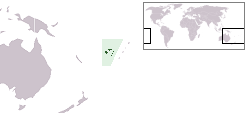The island was first settled around 850 BC by people who were part of the Eastern Lapita cultural complex. [4] According to oral tradition, Cikobia-i-Ra was settled by Manaoneata and his son Iri-ni-buno, who came from Laucala in Cakaudrove. [1] One of Manaoneata's sons settled later on Naqelelevu. [1] Other accounts, recorded by Bruce Biggs, state that a chief called Sau Mata-i-walu spent time in Cikobia-i-Ra before discovering Naqelelevu. [1]
Cikobia-i-Ra's language is most closely related to Naqelelevu's and exchanges between the two islands and the island of Futuna have been reconstructed through linguistic analysis. [1]
Korotuku complex
At Korotuku a defensive fort was built, which contained ninety different structures, as well as burials. [4] In 1997 a team of archaeologists from Fiji and France investigated the archaeological remains on the island. [6] They identified twenty-five funerary sites on the island, most of which related to the historic period (c.1850), [7] and whose history is attested in the island's oral culture. [4] The team excavated ten interments, which included two children and eight adults, five of whom could be identified as males, two of which females. [4] A number of grave goods were found, including glass trade beads, a qato – which is an armband made of Trochus shell, a boar's tusk, a shark's tooth and a coral object which was tentatively identified as part of a tabua – a ceremonial object which accompanied a person into the afterlife. [4] It is likely that the bodies were wrapped in tapa prior to burial. [4] A later study used stable isotope analysis to examine the diets of those buried there, concluding that they ate a diet based primarily on vegetal food, with some shellfish consumption, which has been interpreted as dietary selection which may indicate those buried were part of an island elite. [7]
As part of the archaeological work instigated in 1997, Fijian colleagues undertook oral history work with the island's community to better understand the site. [8] In response, islanders began to rebuild one of the fortifications, known as Rukunikoro. [8] Years after work ended, families still tended the project, explaining that they preferred to keep tourists away, that it was for themselves, not for others. [8]
Glass beads have been excavated from graves on the island, which originated in Europe in the nineteenth century and may have been brought to the island by American whalers or European sailors, during the period of colonisation. [9]

